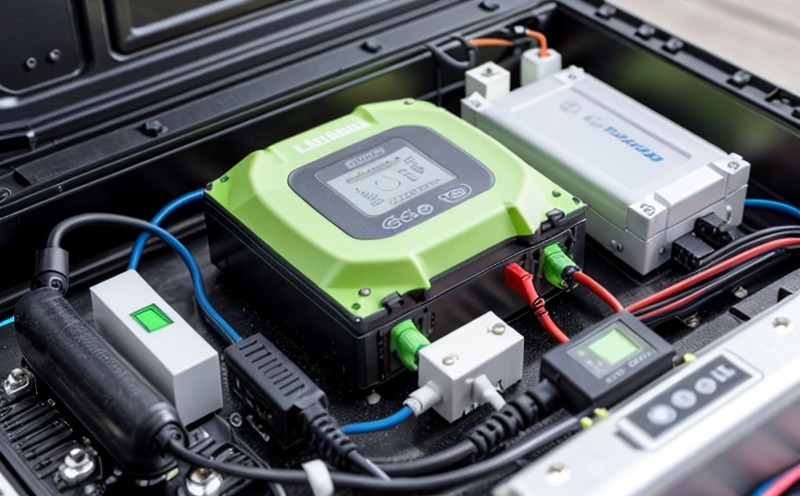JIS C8715-2 Lithium-Ion Rechargeable Battery Testing for Portable Equipment
The JIS C8715-2 standard is a crucial document for manufacturers and quality assurance teams involved in the development, testing, and certification of lithium-ion rechargeable batteries used in portable equipment. This service focuses on ensuring that these batteries meet stringent safety and performance requirements to protect users and comply with international standards.
Lithium-ion batteries are widely used in various portable devices such as smartphones, laptops, tablets, and other consumer electronics. These batteries must be rigorously tested to ensure they perform reliably under different conditions, last long enough for the intended use, and remain safe during operation. The JIS C8715-2 standard provides a framework for testing these batteries according to specific parameters that reflect real-world usage scenarios.
The test protocol outlined in this standard is designed to evaluate the battery's ability to withstand various stresses, including overcharging, overdischarging, and short-circuiting. It also includes tests for temperature cycling, vibration, and mechanical impact. These tests are essential because they help identify potential weaknesses early on, preventing failures that could lead to safety hazards or product recalls.
One of the key aspects of JIS C8715-2 is its emphasis on ensuring the battery's integrity under extreme conditions. For instance, the high-temperature charge test (Section 6) simulates situations where a user might leave their device in a hot environment, such as inside a car during summer. Similarly, the low-temperature discharge test (Section 7) checks how well the battery functions when exposed to cold temperatures, which can occur if someone uses an outdoor device like a GPS or camera.
The standard also includes tests for ensuring that lithium-ion batteries are not only safe but also efficient in terms of energy storage and delivery. The internal resistance measurement (Section 8) helps assess how efficiently the battery can convert chemical energy into electrical power, which is critical for maintaining optimal performance over time. Another important test is the self-discharge rate determination (Section 9), which measures how quickly a fully charged battery loses its charge when not in use.
By adhering to JIS C8715-2 and other relevant international standards like IEC 62619, manufacturers can ensure that their lithium-ion batteries are reliable, safe, and meet the expectations of consumers. This not only enhances brand reputation but also contributes to a safer product ecosystem by minimizing risks associated with faulty or poorly designed batteries.
The testing process typically involves several stages, starting with initial screening tests to identify any obvious issues. If these pass, more detailed tests follow, which may include accelerated aging studies and capacity retention tests over extended periods. These comprehensive evaluations provide insights into the battery's long-term stability and predict its useful life under expected conditions.
For quality managers, compliance officers, R&D engineers, and procurement professionals involved in this field, understanding JIS C8715-2 is vital. It ensures that batteries are developed with consideration for all potential hazards and performance metrics, leading to safer products that meet market demands effectively.
Applied Standards
The JIS C8715-2 standard is part of a broader set of international guidelines designed to ensure the safety and reliability of lithium-ion batteries. Some key standards that complement this service include:
- IEC 62619: This European standard provides additional guidance on battery systems, including safety requirements for portable electronic devices.
- UL 38750: Developed by Underwriters Laboratories, this standard sets specific criteria for evaluating the safety of lithium-ion batteries used in consumer electronics and other applications.
- CNS 14962: This Taiwanese national standard specifies the methods for testing rechargeable lithium-ion secondary batteries used in portable equipment.
These standards work together to provide a comprehensive approach to assessing the safety, performance, and longevity of lithium-ion batteries. By adopting these guidelines, manufacturers can ensure their products meet global regulatory requirements and industry best practices.
Industry Applications
The application of JIS C8715-2 Lithium-Ion Rechargeable Battery Testing for Portable Equipment extends across multiple industries where portable electronic devices play a significant role. Some key sectors include:
- Consumer Electronics: Smartphones, tablets, and other consumer gadgets require reliable battery performance.
- Laptops and Ultrabooks: These devices need long-lasting batteries to support extended usage without frequent recharging.
- Medical Devices: Portable medical equipment such as defibrillators rely on stable power sources for critical operations.
- Sports and Fitness Gear: Devices like GPS watches and fitness trackers must operate efficiently in various environmental conditions.
By ensuring compliance with JIS C8715-2, manufacturers can address the diverse needs of these industries while maintaining high standards of quality and safety. This helps build trust among consumers who value reliability and performance from their devices.
Customer Impact and Satisfaction
Adhering to JIS C8715-2 Lithium-Ion Rechargeable Battery Testing for Portable Equipment has significant benefits for both manufacturers and end-users. For customers, the primary advantage is enhanced safety. Knowing that their devices are tested according to rigorous standards fosters confidence in the products they purchase.
Manufacturers also benefit from this service as it helps them identify areas for improvement early in the product lifecycle. By detecting potential issues through thorough testing, companies can reduce warranty claims and improve overall customer satisfaction. This proactive approach not only strengthens brand loyalty but also enhances market competitiveness by delivering superior quality products.
In addition to these direct advantages, implementing JIS C8715-2 contributes positively to broader industry trends towards sustainability and environmental responsibility. By ensuring that batteries are designed with safety in mind, manufacturers play a role in reducing waste associated with faulty or poorly performing devices. This aligns with growing consumer awareness about eco-friendly practices and responsible disposal methods.
Overall, the impact of this service reaches far beyond individual products; it promotes a culture of excellence within the industry, encouraging continuous improvement and innovation that benefits all stakeholders involved.





